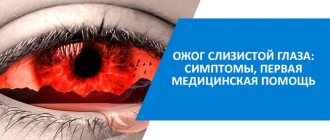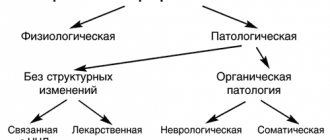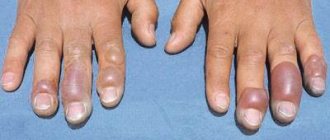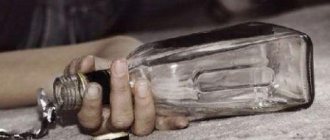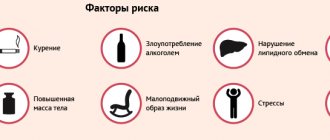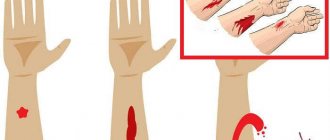Last update: 01/14/2020
A chemical burn occurs when the skin comes into contact with acids, alkalis, salts of heavy metals and other caustic substances. Lesions of the epidermis upon contact with substances are divided into four degrees of severity:
- I degree – slight redness and pain from touching.
- Stage II – the appearance of bubbles with clear liquid.
- III degree – large blisters filled with cloudy liquid and bloody discharge, impaired sensitivity.
- IV degree – damage to all tissues down to the bone.
Regardless of the degree, first aid for a chemical burn is the same. In case of severe injuries (from stage III), you need to call a doctor, and then begin providing first aid.
Step-by-step first aid for chemical burns
- Remove the victim's clothing and jewelry
that may have been exposed to drops of the chemical. - Rinse
the affected surface for 20-30 minutes (depending on the degree of damage). - Do not use wipes or cloth to remove the caustic substance. You will rub it further into your skin.
- If the burn is caused by alkali
, then after rinsing with water, the skin should be washed with a solution of citric or boric acid (half a tablespoon per glass of water). The acid neutralizes the alkali. - In turn, the alkali neutralizes the acid
. Therefore, if the burn is caused by acid, you need to wash the skin with an alkaline solution, for example, soapy water. - If the burn is caused by hydrofluoric acid
(which is contained, for example, in brake fluid), you need to rinse the skin under running water for at least two hours. - Do not wash your skin with water if you are burned with slaked lime!
First, remove the lime using a piece of clean cotton cloth. And only then rinse the surface and wipe with vegetable oil. - Apply a sterile bandage to the burn area (alternatively, a bandage soaked in warm water). A gauze pad treated with antibiotic ointment can be placed under the bandage. This is necessary to disinfect the skin in case of a chemical burn.
- Take to hospital for further treatment if the severity of the chemical burn is above second degree.
Burns with acids and alkalis characteristic signs and features
Each substance has its own individual differences when interacting with human skin. Acid burn
Acid lesions most often do not cause serious consequences. Causes superficial damage. The type of acid is determined by changes in skin color. Symptoms of a chemical burn:
- Carboxylic acid changes the color of the surface to a brown tint.
- The skin turns dark brown after vinegar essence.
- Hydrochloric acids change the skin tone to yellow.
- After sulfur, the color changes to gray.
- Nitric acid changes its hue to yellow-green.
Acid damages and greatly dries out the epidermis. Therefore, the surface is dense, dry, with clear boundaries of the affected area. Tissue swelling does not occur; a deepening of the affected area is more often observed. His sinking. The dehydrating and cauterizing effect eliminates the formation of blisters. Alkali burn
Alkali is characterized by permeability. It quickly passes under the epidermis. Damages the deep layers of the dermis. The scab will be without clear boundaries, loose, whitish in color. The lesions are predominantly white. The crust forms and separates rather slowly. This greatly slows down the healing process. Characteristic signs of an alkaline burn:
- redness;
- edema;
- irritation;
- burning;
- strong pain.
Caring for burn-damaged skin
The more attention you pay to caring for your skin after a chemical burn, the faster the surface will heal and the less likely you are to be left with a scar forever.
The rules of care are simple: do not use substances that irritate the skin. These include almost all alcohol-based products, fragrances and alkaline compounds (soaps, shampoos). Use creams that do not contain potent substances or allergens. They will soften the skin, provide enhanced nutrition for quick treatment of chemical burns and protect the epidermis from possible damage.
La-Cri cream was developed by doctors to care for the most sensitive skin, including those damaged by chemical burns. There are no allergens in it (therefore they can be used even in baby skin care), but there are many nourishing plant extracts that are responsible for regeneration.
Surgical intervention
Surgical treatment is used only if other methods do not give the desired result. For each specific patient, the surgical method is selected depending on the severity of the lesion. There are several types:
- Necrotomy. Changed tissues are removed. The operation prevents the spread of necrosis and allows tissue and blood supply to be restored to the damaged area.
- Necrectomy is performed mainly in cases of grade 3 and a small area of damage. The wound is thoroughly cleaned to prevent purulent processes and ensure rapid recovery.
- Partial necrectomy. The surgical intervention is similar to necrectomy. It is carried out in a gentle manner, in parts. Helps make it easier to cleanse wounds with large lesions.
- Skin transplantation. For extensive injuries, skin grafting is performed.
- Amputation. It is carried out for very severe lesions to prevent the progress of tissue death.
Experts' opinion
Based on the results of numerous clinical studies, La-Cri products are recommended by the St. Petersburg branch of the Union of Pediatricians of Russia.
According to the results of clinical studies conducted by the Union of Pediatricians of Russia, it was proven that when using a complex of products, the level of skin moisture decreased by 4% in comparison, and in the group that used placebo, the level of moisture decreased by 9%.
The conducted clinical study proves the high efficiency, safety and tolerability of products for daily skin care of children with mild and moderate forms of atopic dermatitis and during remission, accompanied by a decrease in the quality of life of patients. As a result of therapy, a decrease in the activity of the inflammatory process, a decrease in dryness, itching and flaking was noted.
Cream "La-Cri" for sensitive skin:
- reduces itching and irritation;
- relieves skin redness;
- moisturizes and gently cares for the skin.
Degrees of burns
Experts distinguish 4 degrees of tissue injury:
• I degree - superficial damage to the epithelium, accompanied by redness of the skin, slight swelling and mild pain. Healing occurs in 3-4 days and usually does not require drug treatment.
• Stage II - fluid-filled blisters appear. When they open, a reddish erosion is exposed. Such burns heal in 10-12 days; scars usually do not form. Medical attention may be required.
• III degree - the deep layers of the skin are damaged, blisters (2 or more cm) are formed, filled with a bloody or jelly-like mass. Necrosis of the affected areas occurs. Such burns require mandatory clinical treatment, which can last up to 3 months.
• IV degree - very deep damage to the deep layers of the skin, fatty tissue, muscle tissue, blood vessels and nerves, down to the bones and charring state. A dark crust forms. The development of purulent complications is likely. Treatment takes several months.
Important!
You should seek medical help if you suspect grade II or higher. The area of damage is important - if it is larger than the size of the palm, the victim should immediately call an ambulance. In severe cases of burns, infection, intoxication of the body, and disruption of metabolic processes in tissues are possible. The development of painful shock cannot be ruled out.
Consumer Reviews
missis-mixeeva (otzovik.com)
“The La-Cree cream was recommended to me at the pharmacy as a replacement for fenistil, it costs almost 500 rubles, it’s too expensive. La-Cri cream costs several times less and, according to the seller at the pharmacy, has virtually no difference.
Regular paper packaging, almost all in blue-green tones. The packaging depicts a child and indicates that the cream can be used by children from 0 years old. It is also stated that the cream has no fragrances or dyes...
Water, avocado oil, panthenol, cetyl stearyl alcohol, boat extract, walnut extract, violet extract and some other additives.
Active components:
- Avocado oil 3%
- Panthenol. 2.5%
- Licorice extract 1%
- Walnut extract 0.7%
- Bisabolol. 0.2%
- Violet extract. 0.2%
- Rosewood oil 0.12%
- Seed extract. 0.05%
Now I’ll tell you a little about some of the components.
Avocado oil:
The oil is rich in vitamins, microelements and saturated with fatty acids, the fat composition is as close as possible to the fats of human skin, therefore all the beneficial substances contained in the cream penetrate the skin, thereby providing its nutrition.
I won’t talk about panthenol, since every mother is familiar with panthenol cream firsthand.
Walnut extract:
It is an antibacterial herbal remedy, has an anti-inflammatory and wound-healing effect.
Violet extract:
Violet is rich in essential oils and vitamins. Violet extract improves skin hydration and elasticity.
The cream in the pharmacy costs 248 rubles, depending on the pharmacies the cost may vary. Thank you for your attention.”
pija456 (otzovik.com)
"Good evening! In winter, the skin on your hands becomes too dry, so you have to choose products for sensitive skin. This time I bought La-Cri cream for sensitive skin without fragrances or dyes.
The color is light brown, the smell is herbal. Not greasy, absorbs quickly, leaving the skin velvety.
Developed based on herbal ingredients to relieve itching, irritation and redness of the skin. Active components:
- Avocado oil
- Panthenol
- Licorice extract
- Walnut extract
- Bisabolol
- Violet extract
- Rosewood oil
- Sequences extract.
You can buy this product at a pharmacy.
Thank you for your attention and happy shopping!”
Sources:
- Mancini A. J., Krouchuk D. P., Pediatric dermatology. Publisher: Practical Medicine, Directory, 2018
- Kildiyarova Rita Rafgatovna, Pediatrician for every day. Guide for doctors, publishing house GEOTAR-Media, 2021
- B.A. Shamov, I.G. Safiullina, A.B. Beshimova, T.B. Shamov, Differential diagnosis of atopic dermatitis, journal of Practical Medicine, 2011 https://cyberleninka.ru/article/v/differentsialnaya-diagnostika-atopicheskogo-dermatita
- Fokina R.A., Atopic dermatitis: stages of development of classification forms, Siberian Medical Journal, 2007 https://cyberleninka.ru/article/v/atopicheskiy-dermatit-etapy-razvitiya-klassifikatsionnyh-form
Overview of treatment tools for first aid
To stop the development of a burn injury at the first aid stage, it is necessary to treat the wound with a chemical neutralizing agent.
The products that are found in every person’s kitchen are a good antidote for chemical burn injuries. We are talking about baking soda, ammonia, acetic (or citric) acid. Baking soda helps stop acid activity. Ammonia works in the same way. Having reacted with these substances, the acid is neutralized. Acetic or citric acid helps treat alkaline burns.
In addition to home first aid remedies, there are special medications that can be purchased at the pharmacy.
Miramistin is a drug with anti-inflammatory and antibacterial action. Apply the product to a cotton swab, which is then used to treat the wound. The drug promotes the regeneration of damaged tissues.
Panthenol is an effective remedy for treating chemical burns. Apply a thin layer to the wound. Long-term use of Panthenol promotes rapid healing, prevents the formation of scars and scars.
Solcoseryl is a product that promotes the regeneration of damaged areas by restoring collagen fibers. The drug prevents the wound from drying out, ensuring complete water balance in the skin.
Sudocrem - has a restorative, soothing and protective effect. When treated, it creates a thin film on the wound, which becomes a barrier to various pathogenic bacteria.
Alfogin is a healing cream widely used for thermal, chemical and electrical burns. Thanks to its natural composition, it carefully restores damaged areas, prevents suppuration and inflammation.
Dexpanthenol is an analogue of Panthenol. Has an anti-inflammatory effect, softens and promotes regeneration.
Burnaid Emergency Kit for first aid at home. The set includes 1 sterile bandage measuring 10 by 10 centimeters and a soothing gel (3 pieces). The bandage prevents contamination of the wound surface and cools the skin, and a special gel eliminates pain and has an antibacterial effect.
We recommend reading:
Treatment of chemical skin burns
What to do at home
- Rinse the wound generously, preferably under pressure, for 15-25 minutes. If it is possible to use cold, clean water for these purposes (well, distilled, boiled), it is better to use it - this will help reduce the risk of developing a local infection. Running water is also suitable for this task, since at this time the main thing is to remove the harmful substance as much as possible;
- Prevent wound contamination. It is important to prevent the ingress of soil particles, house dust, biological fluids of people/animals (saliva, blood, etc.), since each of these substances can be a carrier of microbes;
- Anesthetize the patient. Cold water is already a good local anesthetic, but for a short time. If the victim experiences severe discomfort, pain, unbearable itching, you can give him one tablet of NSAIDs (Citramon, Nimesulide, Meloxicam, Ketorolac, etc.) or a combination medicine (Baralgina, Pentalgina);
- If you plan to call an ambulance, you should not apply the bandage yourself - a paramedic or doctor will do it better. When self-referring, the patient should protect the burn surface with an aseptic bandage to prevent contamination. The form and technique of application is not of fundamental importance. The main thing is that the bandage is firmly fixed, but does not overtighten the skin/surface vessels;
- Take to the doctor for a specialized examination and determination of treatment tactics.
Prevention
The basis of prevention is compliance with safety measures when working with any chemical compounds. To prevent household burns from chemicals in children and adults, it is recommended:
- Keep containers with chemicals tightly closed;
- hide chemicals out of the reach of children;
- do not store reagents in close proximity to food or medicines;
- When using chemical compounds, ensure protection of exposed areas of the body.
Employees are allowed to work with caustic reagents in production only after special training.
The child has
A child has a chemical burn - this is usually a household injury that can be caused by any reagents stored at home. Children receive burn injuries due to parental neglect and storage of chemicals in places accessible to children. A small child can spill powder on himself, douse himself with a chemical liquid, spray an aerosol with a dangerous substance, and even taste a caustic compound.
The skin of children is thinner and more delicate, with a highly developed network of blood and lymphatic vessels, and therefore has greater thermal conductivity. That is why exposure to a chemical agent that will cause only superficial damage in an adult will result in a deep burn in a child.
In addition, due to children's helplessness, the chemical remains on the skin longer than in an adult, which also causes deep damage. And due to the imperfection of regulatory mechanisms and compensatory reactions, a burn disease in a child can develop even with damage to 5-10%, and in infancy - only 3-5% of the entire surface of the body.
Burns in children are always more severe than in adults.
